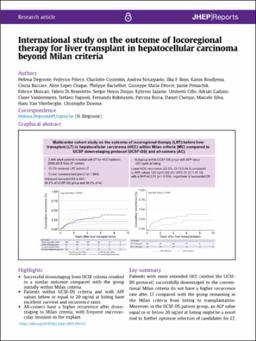International study on the outcome of locoregional therapy for liver transplant in hepatocellular carcinoma beyond Milan criteria

View/
Date
2021-07Author
Piñero, Federico.
Degroote, Helena.
Costentin, Charlotte.
Et al.
Metadata
Show full item recordAbstract
Abstract
Background & aims: Good outcomes after liver transplantation (LT) have been reported after successfully downstaging to Milan criteria in more advanced hepatocellular carcinoma (HCC). We aimed to compare post-LT outcomes in patients receiving locoregional therapies (LRT) before LT according to Milan criteria and University of California San Francisco downstaging (UCSF-DS) protocol and 'all-comers'.
Methods: This multicentre cohort study included patients who received any LRT before LT from Europe and Latin America (2000-2018). We excluded patients with alpha-foetoprotein (AFP) above 1,000 ng/ml. Competing risk regression analysis for HCC recurrence was conducted, estimating subdistribution hazard ratios (SHRs) and corresponding 95% CIs.
Results: From 2,441 LT patients, 70.1% received LRT before LT (n = 1,711). Of these, 80.6% were within Milan, 12.0% within UCSF-DS, and 7.4% all-comers. Successful downstaging was achieved in 45.2% (CI 34.8-55.8) and 38.2% (CI 25.4-52.3) of the UCSF-DS group and all-comers, respectively. The risk of recurrence was higher for all-comers (SHR 6.01 [p <0.0001]) and not significantly higher for the UCSF-DS group (SHR 1.60 [p = 0.32]), compared with patients remaining within Milan. The all-comers presented more frequent features of aggressive HCC and higher tumour burden at explant. Among the UCSF-DS group, an AFP value of ≤20 ng/ml at listing was associated with lower recurrence (SHR 2.01 [p = 0.006]) and better survival. However, recurrence was still significantly high irrespective of AFP ≤20 ng/ml in all-comers.
Conclusions: Patients within the UCSF-DS protocol at listing have similar post-transplant outcomes compared with those within Milan when successfully downstaged. Meanwhile, all-comers have a higher recurrence and inferior survival irrespective of response to LRT. Additionally, in the UCSF-DS group, an ALP of ≤20 ng/ml might be a novel tool to optimise selection of candidates for LT.
Clinical trial number: This study was registered as part of an open public registry (NCT03775863).
Lay summary: Patients with more extended HCC (within the UCSF-DS protocol) successfully downstaged to the conventional Milan criteria do not have a higher recurrence rate after LT compared with the group remaining in the Milan criteria from listing to transplantation. Moreover, in the UCSF-DS patient group, an ALP value equal to or below 20 ng/ml at listing might be a novel tool to further optimise selection of candidates for LT.
Keywords: AC, all-comers; AFP, alpha-foetoprotein; All-comers; Alpha-foetoprotein; DS, downstaging; Downstaging; EASL, European Association for the Study of the Liver; HCC, hepatocellular carcinoma; HR, hazard ratio; Hepatocellular carcinoma; ITT, intention to treat; LR, liver resection; LRT, locoregional therapies; LT, liver transplantation; MC, Milan criteria; MVI, microvascular invasion; PEI, percutaneous ethanol ablation; RFA, radiofrequency ablation; SHR, subdistribution hazard ratio; TACE, transarterial chemoembolisation; UCSF downstaging protocol; UCSF-DS, University of California San Francisco downstaging; UNOS, United Network for Organ Sharing; WL, waiting list.
© 2021 The Authors.
Collections
The following license files are associated with this item:

